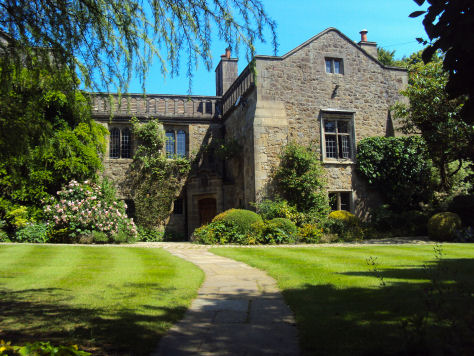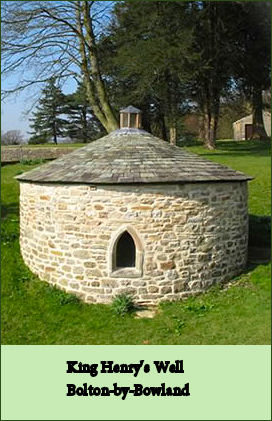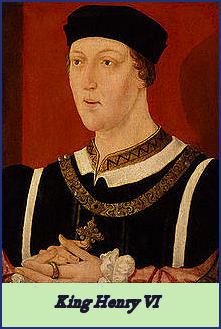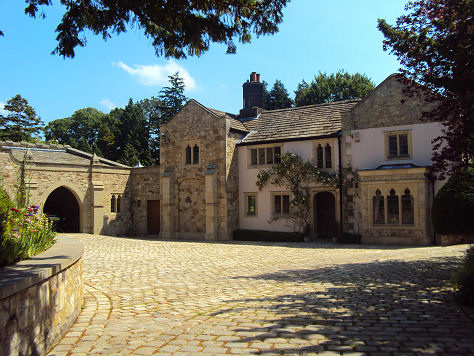Waddington Hall and King Henry VI
OS grid ref:- SD725435
 Medieval Waddington Hall, (pictured left) in the picturesque village of Waddington, in Lancashire, is famous for its link with King Henry VI, last monarch of the House of Lancaster. Following the Battle of Hexham in 1464, a decisive victory for the rival house of York, Henry was forced to flee and was given refuge at Waddington Hall for a year. He also took refuge at Bolton Hall and Clitheroe Castle.
Medieval Waddington Hall, (pictured left) in the picturesque village of Waddington, in Lancashire, is famous for its link with King Henry VI, last monarch of the House of Lancaster. Following the Battle of Hexham in 1464, a decisive victory for the rival house of York, Henry was forced to flee and was given refuge at Waddington Hall for a year. He also took refuge at Bolton Hall and Clitheroe Castle.
The gateway of Waddington Hall is surmounted by a hand carrying a lance and battle-axe, and underneath is the inscription "I will raise up his ruins, I will build it as in the days of old." Parts of the building, including the the Monks Room, date back to the eleventh century and other parts from the thirteenth century. A room in the house retains the name of 'King Henry's chamber'.
The owners, the Tempest family, were lords of the manor of Waddington from at least the early thirteenth century, when they inherited through the marriage of their ancestor, Sir Roger Tempest to Alice, the daughter and heiress of Walter de Waddington, in the reign of Edward I. The Tempest family remained at the hall until the reign the Sturt king, Charles I. They are credited with endowing the village church at Waddington. One of the family, Nicholas Tempest, a Bowbearer of the Forest of Bowland, was hanged, drawn and quartered at Tyburn in 1537 for being amongst the leaders of the Pilgrimage of Grace, a rebellion fired by discontent and ill feeling at hardship in the largely Catholic north caused by the dissolution of the monasteries.
 After loosing the battle of Hexham, King Henry, relying on Lancastrian partisans for shelter, was given refuge by Sir John Pennington at Muncaster Castle in Cumbria. On leaving Muncaster, he presented the Penningtons with his glass drinking bowl, now known as ‘The Luck of Muncaster’ it is still survives to the present day at the castle.
After loosing the battle of Hexham, King Henry, relying on Lancastrian partisans for shelter, was given refuge by Sir John Pennington at Muncaster Castle in Cumbria. On leaving Muncaster, he presented the Penningtons with his glass drinking bowl, now known as ‘The Luck of Muncaster’ it is still survives to the present day at the castle.
He was then given refuge by the Pudsay family at Bolton Hall in Bolton-by-Bowland, where he is reputed to have divined a well, still known as King Henry’s Well. The well survives to the present day as a Listed Ancient Monument and has recently been restored, the well may be seen from the public footpath. The site of the old Hall and grounds are now known as King Henry’s Mews. It is said that that the design of the tower of the vilage's fifteenth century church was influenced by Henry VI.
 On leaving Bolton Hall, Henry presented his host with gifts of a pair of fine brown Spanish leather boots, lined with deer-skin, a pair of gloves, and a spoon. Sir Ralph Pudsay died in 1468, and is buried in the village church of St. Peter and St. Paul, his monument is situated in the arch between the chancel and chapel. It is carved with the figures of Sir Ralph wearing full armour, along with his three wives, and his 25 children, with their names. After his sojourn at Bolton-by-Bowland, Henry moved to nearby Waddington Hall, where he remained as the guest of Richard Tempest for about a year.
On leaving Bolton Hall, Henry presented his host with gifts of a pair of fine brown Spanish leather boots, lined with deer-skin, a pair of gloves, and a spoon. Sir Ralph Pudsay died in 1468, and is buried in the village church of St. Peter and St. Paul, his monument is situated in the arch between the chancel and chapel. It is carved with the figures of Sir Ralph wearing full armour, along with his three wives, and his 25 children, with their names. After his sojourn at Bolton-by-Bowland, Henry moved to nearby Waddington Hall, where he remained as the guest of Richard Tempest for about a year.
‘Waddington Hall, in the Yorkshire part of this parish, afforded an asylum for twelve months to the unfortunate Henry VI after the Battle of Hexham, but at length his retreat was discovered by the prying eye of Sir James Harrington, aided by Thomas Talbot, the son of Sir Edmund Talbot, and his cousin, John. The Royal fugitive, when he found that he was betrayed, escaped across the Ribble, over Brungerley Hipping (Stepping) Stones, and sought concealment in Clitheroe Wood, but being hotly pursued he was taken, and ignominiously conveyed to London.’ - Baine’s History of the County Palatine of Lancaster.
Richard Tempest's brother, John Tempest, who was loyal to the rival Yorkist King, Edward IV, was not informed of the true identity of Richard's guest, but another visitor to the hall, William Cantlow, 'a black monk of Abingdon' did recognise the king and felt it his duty to inform John, who took part in a raid on the house to capture the king, which took place just as Henry was about to sit down to dinner with Dr Manning, the Dean of Windsor, armed men burst into the hall. John Tempest demanded Henry reveal his true identity, to which John Tunstall sprang to his defence, unsheathing his sword and in a violent struugle, broke John Tempest's arm. Tunstall is then said to have helped Henry to escape via a secret panel and staircase from the dining room.
Pursued on horseback, the king and the faithful Tunstall were eventually captured at nearby Brungerley Bridge on the outskirts of the town of Clitheroe.
 Members of the Talbot family, Sir John Tempest and Sir James Harrington were instrumental in the capture of the king, a grant of lands was made by King Edward IV to Sir James Harrington "for his services in taking prisoner, and with holding as such in diligence and valour his enemy Henry, lately called King Henry VI." Henry was kept overnight at Clitheroe Castle before being conveyed south on horseback with his legs tied to his horse’s stirrups. He was handed over to Richard Neville, Earl of Warwick at Islington.
Members of the Talbot family, Sir John Tempest and Sir James Harrington were instrumental in the capture of the king, a grant of lands was made by King Edward IV to Sir James Harrington "for his services in taking prisoner, and with holding as such in diligence and valour his enemy Henry, lately called King Henry VI." Henry was kept overnight at Clitheroe Castle before being conveyed south on horseback with his legs tied to his horse’s stirrups. He was handed over to Richard Neville, Earl of Warwick at Islington.
Warksworth's Chronicle records- 'Also the same yere, Kynge Herry was takene bysyde a howse of religione in Lancaschyre, by the mene of a blacke monke of Abyngtone , in a wode called Cletherwode, besyde Bungerly Hyppyngstone , by Thomas Talbott , sonne and heyre to Sere Edmunde Talbot of Basshalle, and Jhon Talbott his cosyne of Colebry, withe other moo; whiche disseyvide, beyngne at his dynere at Wadyngtone Halle , and caryed to Londone on horse bake, and his lege bownde to the styrope , and so brought thrugh Londone to the Toure.'
The hapless Henry was imprisoned in the Tower of London by his cousin and rival, the Yorkist king, Edward IV, where he later met his death after the Battle of Tewskesbury.
The majority of contemporary chroniclers believed Henry had been murdered. After the passage of over five hundred years this can never be properly ascertained, due to controversy over the manner of his death, George V gave permission to exhume the body of King Henry VI in 1910. The skeleton was found to have been dismembered before being placed in the box and not all the bones were present. Three very worn teeth were found and the only piece of jaw present had lost its teeth before death. The bones were recorded as being those of a strong man measuring five feet nine to five feet ten inches tall. Light brown hair found matted with blood on the skull confirmed that Henry VI had died as a result of violence.
